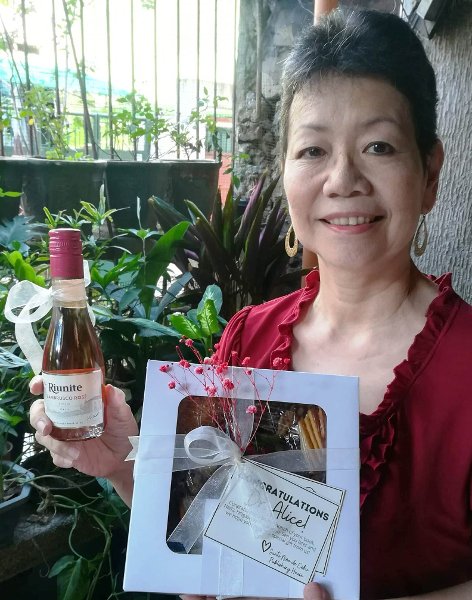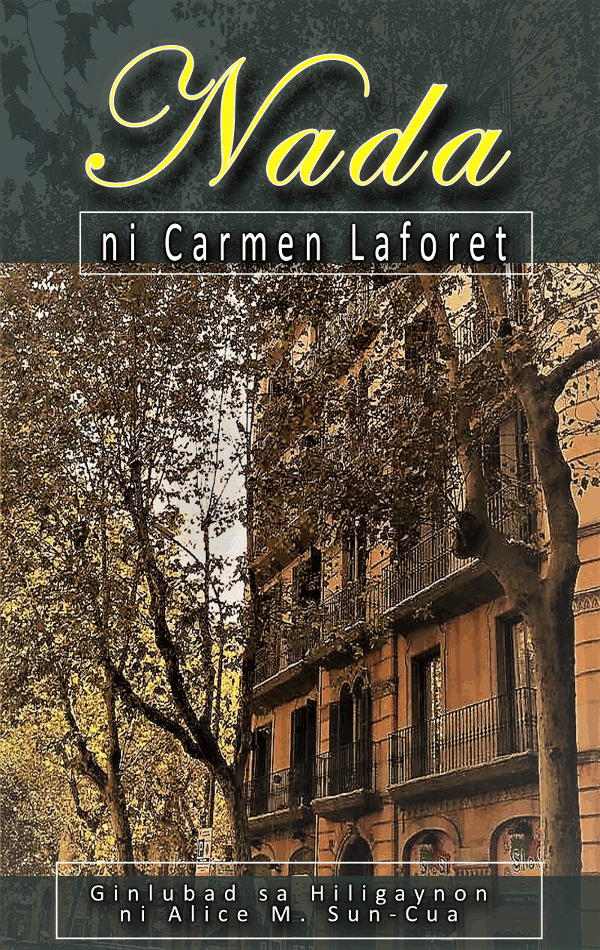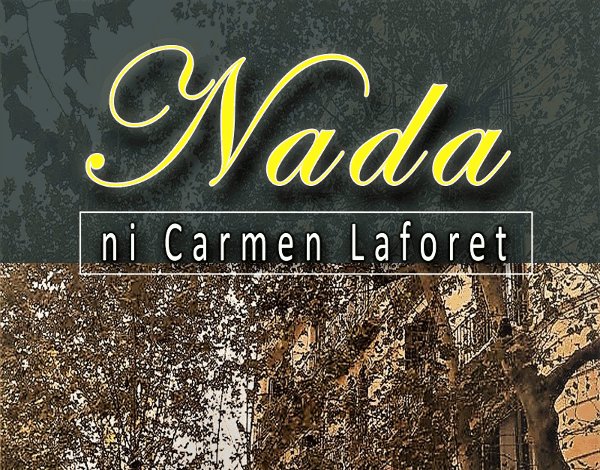
Dr. Alice Sun Cua posing with gifts from the Sto. Nino de Cebu Publishing House.
Alice Sun Cua, a perennial Manila Critics’ Circle awardee, is that rare creature. She is a physician (obstetrics-gynecology is her specialty at San Juan de Dios Hospital) by day and a literary writer and now a translator during her free hours.
The Santo Niño de Cebu Publishing House recently launched its first title, and the good doctor was their buena mano. It published her translation of contemporary Spanish novelist Carmen Laforet’s novel Nada in Hiligaynon.
She said of the Visayan language and why she embarked on the self-motivated project: “To encourage more readers in our regional language is one of the tasks of this translation. Hiligaynon is spoken by more than seven million people in the Visayas: in Iloilo and Negros Occidental and also in Cotabato City and Davao City. Migrants speak it, too, wherever they are found. Bringing this Spanish contemporary classic closer to Hiligaynon speakers is a joyous undertaking, knowing that one has somehow bridged the language gap between the two languages. I hope this translation will hold a bright light to Laforet’s novel, especially because it has so many ‘shadowed’ corners, literally and figuratively, that the word la tiniebla or ‘the dark’ may well describe it. Hopefully with this translation, more readers can appreciate her works, and enjoy the story. Perhaps this will be the start of a desire in them to learn Spanish so they can read not only this novel but also other classic and contemporary literary works, in the original Spanish. Learning another language means broadening our horizons, opening ourselves to a different world, to an exciting new universe.”

Book cover of Nada, translated from the original Spanish by Alice Sun Cua.
She was in Spain when she stumbled upon the novel. She recalled, “In one of my visits to the bookstore Casa del Libro along Gran Via in Madrid, I chanced upon a book entitled Nada by Laforet. I was in the intermediate level of my Spanish classes at the Instituto Cervantes de Manila then, but the first few pages that I browsed through surprised me. There were some new words, some strange conjugations, but I could understand the beginning of the story. It grabbed me by the throat. I was hooked. I brought the book home. But because I read very slowly, it took me almost six months to finish the novel, marvelling at the twists and turns of the life of the protagonist Andrea. The manner of living during immediate post-war Barcelona, described in minute details in the book, was an eye-opener for me.”
She related to the protagonist Andrea “because I grew up in the province of Iloilo, and came to Manila for the first time in my life to study medicine at the University of Santo Tomas. In school, with my halting Tagalog, I felt very awkward, and had that feeling of never belonging, of being an outsider. My old-fashioned dresses, even my shoes, simply shouted, provinciana. This feeling never left me for a long time. Those first few months in Manila were difficult for me, my needing to adjust to the faster-paced lifestyle of Manila, meet and make new friends. That’s why I learned Cebuano first as almost all my friends were from Cebu and Davao, fellow provincianas.”
Her work on the translation began as a thought in 2017 when she assumed that she could do the work on the whole novel as her Ph.D. dissertation in translation, “a dream that until now remains a dream.”
She said, “I got caught up in the whirlwind of the translation fever, and knowing that waiting for that doctoral degree would take years, I went on and finished the translation. My mother, who used to be only a phone call away about the needed Hiligaynon words, was no longer with us. Those were the many times that I really missed her. We spoke Hiligaynon between us, and sometimes I find myself groping for the words that somehow remain at the tip of my tongue or thought. They do not come out as easily as before so I felt that this project has brought me closer to home, to Hiligaynon.”
She continued, “I would like to reach out and recover the voice that I grew up with, a language that, after the death of my mother, I hardly use now. It is a language I associate with my childhood, of a life filled with joy and happy family life, of home, wherever home may be.”
Asked what are the strengths of Hiligaynon that make it suitable for translating something from Spanish, she replied, “There are many Hiligaynon words, like Filipino and Cebuano, or even Ilocano that come from Spanish. The translation was a voyage between two almost similar languages. Many times I had to wrestle with words that were falsos amigos or ‘false friends.’ One example would be the word bañera, which meant ‘bathtub’ in Spanish. In Hiligaynon, the word, spelled banyera meant a large, round receptacle for water. To go around this I used bañera in italics and explained what it really was at the end of the chapter.”
She honed her skills in reading and understanding Spanish in high school, “mainly conjugation, helpful conversational phrases and memorizing Rizal’s ‘Mi Último Adios.’ The latter exempted us from final exams! I felt it was fun because I grew up in a multi-lingual family. I spoke Chinese Fookien with my father, Hiligyanon with my mother, I heard Kiniray-a from my yaya and other household members. I learned English and Chinese Mandarin in school and the movies. I had six semesters of required Spanish classes in college where I discovered the books of Cervantes, Machado, Lopez de Vega, Quevedo. When a close friend who was a career diplomat was assigned to Madrid, I thought it would be interesting to brush up my Spanish and practice it when I visited him. In August 2000, I started my Spanish classes at Instituto Cervantes, from the first grade, Nivel Primero, which is called A1 now. Who knew that it led to a lifelong interest in the Spanish language and culture so that even until now a group of us like-minded Hispanophile friends, already done with all the academic requirements, continue to enrol in Spanish lessons at the Instituto where we immerse ourselves in a deeper and more nuanced learning, guided by our professors through the years. We’re in here for the long-haul, because learning is always pleasurable and fascinating.”
Her favorite writer in Spanish is Gabriel Garcia Marquez “because of his sweeping sagas, his attention to minute details, his magic realism, and he could really tell a story. I’ve been trying to finish Don Quixote because of the lessons in life we learn from this novel by Cervantes. Pablo Neruda and Octavio Paz for their deep poetry, Luis Borges for his labyrinthine stories and poetry, Julio Cortázar, Mario Benedetti, Carlos Fuentes, Isabel Allende, Carmen Martin Gaite, Arturo Muñoz Molina and many others.
Sought for her opinion on the state of translation works of world literature in other Philippine languages and why translation is of vital importance, Sun Cua said, “There are many translations now of world literature into Philippine languages, especially into Filipino, but there are also a lot that has been translated into Bicol, Cebuano, Kapampangan. One example is the Recoged esta voz (Gather this voice, Fundación Miguel Hernández and Instituto Cervantes, 2004), an anthology of the poems of Hernandez translated into Filipino, Bicolano, Cebuano, Ilocano, Kapampangan, Hiligaynon, Cebuano and Chabacano where John Iremil and I were in the Hiligaynon panel. It meant bringing the Hernández poems closer to those who do not read Spanish, ferrying them, as it were, into the banks of Orihuela, the hometown of the poet, and helping the readers understand what the poems meant.”
Meanwhile, she is also at work on another collection of travel narratives and some memory pieces on Iloilo City, “both a good exercise for my memory, which at times fail me now. It is always good to have an orderly written account of things because sometimes my travel and daily journals are not systematic enough. Perhaps another translation, if something interesting comes up. I have started a collection of poetry when the pandemic struck.”
When asked how she divided her time between her active medical practice and the training of young colleagues and writing/translating, she replied, “After all these years I have slowly learned to compartmentalize the clinical and writing tasks. My patients will always be a priority so even if a good line comes, especially for a poem, and I am in the operating or delivery room, I have to put it in a mental folder first rather than unscrub and get paper and pencil to write them down. I have a simple lifestyle which helps in my writing. I usually set aside the early mornings for my writing and meditation after a cup of coffee. Even before the pandemic, I rarely go out unless with close friends or with my husband Alex. I must confess that I do not watch any movies or television at all. My evenings are usually spent reading and writing, although I also bring non-medical books to my clinic and while labor watching.”
Copies of Nada are available at Solidaridad Bookshop on Padre Faura street, Ermita, Manila, or through Santo Nino de Cebu Publishing House’s Facebook page.
